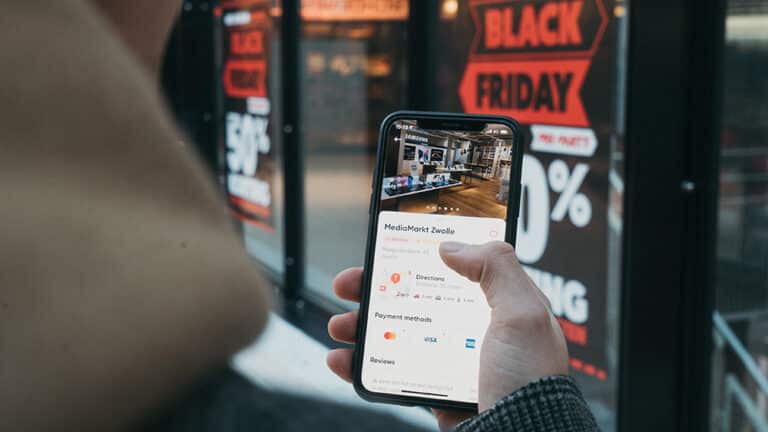Background
Facebook has over 2.7 billion users every month in the world since the first version was launched in early 2004, and is the only social platform that has over half of all social media users. Facebook’s website is the world’s third most visited website, after Google and Youtube and Facebook´s app is the second most downloaded app after TikTok in 2020, according to statistics from Hootsuite. Today’s Facebook users spend an average of almost 34 minutes on the platform everyday.
About ten years ago Instagram was launched and today the app has over a billion active users every month in the world. The app is used by 51% women and 49% men and they spend an average of 30 minutes in the app every day. Of these, 81% of users use the app to search for products or services. Nearly 130 million of those who use the app click on posts related to shopping every month.
Development of paid marketing
For ten years, we have been able to use paid marketing in social channels. Advertising is a cost-effective way to reach more than your followers, and interact with new leads. Advertising in social channels has opened up new business opportunities and contributed to the growth of e-commerce.
Opportunities with advertising on Facebook and Instagram
Advertising through Facebook Family of Apps opens up the possibilities of reaching the right target group by having a large database of Facebook users and building your target groups. You can create target groups according to what your target group has for interests, demographics, age and then create lookalike target groups after your existing customers.
The target groups that have similar interests and behaviors with your already qualified target groups. Once you have gathered data about the target group, you can also work smart with remarketing through the pixel on your website. Your advertising can help you, among other things: drive conversions, increase traffic to your website, strengthen your brand awareness and build loyalty among both potential customers and existing customers or recruit new employees.
What you need to get started with advertising on Facebook and Instagram
The first thing you need to get started with your advertising is to set up a business account in Facebook Business Manager and then create a business page, then in Business Manager you can create an ads account. You have to use the same information that you used when you created your business page.
To be able to measure your advertising we recommend you to have the technical implementation in place before your campaign is live. The reason is to see what your target group interacts with in your ad. On Facebook you can install a pixel, where you choose what you want to measure – so-called events. But the pixel is also to then be able to create retargeting campaigns.
Strategy for your advertising
This is a basic strategy for your advertising on the platform. Further down, we will go through step by step what you should keep in mind when you get started with your advertising.
Objective
You need an objective with your advertising to be able to know what you want to achieve. It may be that you want to drive more conversions, increase brand awareness, get the target audience to download your app, etc.
Target group
Based on what you already know about your target group, for example: age, geographical location or habits.
Content
You need visually appealing content with a message to reach and get the attention from your target audience.
Period
You should keep in mind holidays or other happenings when you are choosing the campaign period. There is often a lot of competition among advertisers and thus more expensive.
Budget
Setting a budget means that you never have to pay more than you intended, you can choose to set a daily budget or a lifetime budget during the period that your ads will run.
Format
There are six flexible ad formats to choose from and they are customized to work on all devices. You choose whether you want to view a picture or video. You can read more about formats down below in this post.
Step by Step: Advertising on Facebook and Instagram
In Facebook Ads Manager, you then get started with your campaign and can create your first ads:
Step 1 – Choose objective for your campaign
Brand awareness
You can choose between brand awareness and reach a lot of people that could be interested in your brand. In this step, you work with a cold audience, that you want to interact with your brand.
App Installations, Traffic, Lead Generation
In this step, you target already prospected (varm) audiences that you want to download your app, visit your website, register to get more information about your company, get in touch via messages, interact with your posts or watch your video to increase interest.
Step 2 – Choose your target groups
You can choose from three tools for build your target audiences:
Core audience – Target groups based on age, interests, geography, etc.
Custom audience – based on users who have interacted with your company by, for example, visiting your website.
Lookalike Audiences – Audiences that you create through your customers’ interests.
Step 3 – Choose placements
Facebook for business is recommending that you include advertising on Instagram, if you create ads for Facebook where the campaign objective also supports Instagram. In this way, you optimize delivery. Choosing automatic placements in Facebook Ads Manager is preferable as Facebook itself optimizes your budget on the placements that work best for maximum results.

Facebook for business is recommending that you include advertising on Instagram, if you create ads for Facebook where the campaign objective also supports Instagram. In this way, you optimize delivery. Choosing automatic placements in Facebook Ads Manager is preferable as Facebook itself optimizes your budget on the placements that work best for maximum results.
Facebook News Feed: Your ads appear in the news feed on your computer when people access the Facebook site on their computers. Your ads appear in the news feed on mobile devices when people use the Facebook app on mobile devices or open the Facebook website in a mobile browser.
Instagram feed: Your ads appear in the mobile feed when people use the Instagram app on mobile devices. Instagram flow ads are only shown to people who use the Instagram app.
Facebook Marketplace: Your ads appear on the Marketplace homepage or when someone browses the Marketplace on the Facebook app.
Facebook video feeds: Your video is displayed between organic videos in video-only environments on Facebook Watch and in Facebook’s news feed.
Facebook right column: Your ads appear in the right column of Facebook. Ads in the right column are only displayed to people who connect to Facebook on their computer.
Instagram – explore: Your ads appear when someone clicks on a photo or video.
Messenger Inbox: Your ads appear on the Messenger Home tab.
A recommendation for more impressions in your advertising is to include Audience Network so that you can reach more people through other apps and also at a lower cost.

Your ads appear in external apps.
Audience Network Native, Banner and Interstitial
Your ads appear in Audience Network apps. Find out more about banner ads, interstitial ads and native ads.
Audience Network Rewarded Video
Your ads appear as videos that people can watch in exchange for rewards in an app (such as currency or in-app items). Find out more about rewarded video.
Dynamic ads
Dynamic ads are for you as an e-merchant, who has a wide range and does not want to create lots of ad sets, but what your dynamic ads help you with is to automatically deliver services and offers to a relevant target group. They work in the same way as other ads that you can choose both placement and goal.
If you are in the beginning of your customer journey, where you want to reach a wide range of cold audiences who have not yet bought anything from your company, you can reach them via dynamic ads. But you can also reach the target audience that has interacted with your products by encouraging them to convert.
Step 4 – Budget
Daily budget: is the average amount you want to spend on an Ad Set or promotion each day and there is no limit.
Lifetime Budget: The total amount you are willing to spend during the entire run of your campaign or Ad Set. Lifetime budget has a fixed limit and no average per day that daily budget has.
Step 5 – Format
Depending on the content and what your message is in your ads, you can choose from these formats:
Image – Display engaging images with appealing click-friendly text.
Video – Create emotions through storytelling and tell your story in moving format
Stories – Inspire your target audience through a mobile-friendly format
Messenger – Get in touch with your target audience
Carousel – Show up to ten pictures, where each has its own link
Slideshow – Video-like ads consist of motion, sound and text.
Collection – Your target group can browse and discover among your range
Playable – Ads that offer a preview before downloading your app
Then you are ready to create your campaign!
Step 6 – Measure your advertising
To be able to see what works or does not work in your advertising, you need to keep track of some important metrics, also called KPIs. These are to ensure that your goal is achieved.
These are the most common KPIs:
- Reach – How much exposure do your ads have?
- Click Through Rate- How many people click on your ad?
- Cost per Click – How much does each click on your ad cost?
- Frequency – How many times does your audience see your ad per week?
- Video engagement rate – How many people interact with your ads through video display length?
- Traffic – How many leads does your website generate for your ads?
- ROAS – What will be your return on advertising costs?
- Conversions – How many convert through your ads?
- Cost per action – What is the cost per lead?
A/B testing
To see what your audience is interacting with and getting involved in, you can create two ads that are similar to each other, but you change small details that can be color, copy, language, etc. Then you can evaluate what attracts your audience and optimize your ads.
Summary
Achieving results in your advertising takes time. You need to give your advertising at least six months to be able to get to know your target audience, know which formats that works, budget distribution, etc. But it is important to dare to try to get there. There is no one-size-fits-all result in advertising other than guidelines for how to go about it. The media landscape is constantly changing and just because your content works today, it does not have to work tomorrow.
Hope you enjoyed the article. Don’t forget to stay updated by subscribing to our newsletter!





